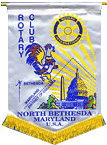
We heard from Cathy Nestoriak, Volunteer Manager at the Jewish Council for the Aging’s Heyman Interages Center. Cathy led an interesting discussion on our inherent biases and subtle discrimination. She had some suggestions on how to become more aware of these issues and encourage more diversity in our club,
The Center‘s intergenerational programs have brought children and older adults together for 30 years. Since 1986, approximately 45,000 children and older adults in more than 100 schools and senior facilities have benefited from participation in our programs.
JCA provides access, answers, and opportunities for older adults and family caregivers throughout the Greater Washington, D.C. region.
Their award-winning programs enable older men and women to maintain their independence, dignity, vitality, and self-respect despite physical, financial and emotional challenges. JCA connect the generations. They shatter stereotypes about growing up and growing older as they help make the National Capital Area a great place to age.
Their Jewish heritage and values guide and inspire their vision and work, and are proud to serve men and women of all faiths, ethnicities and income levels. Since our founding in 1973, JCA has helped all seniors thrive.
A special report prepared for Rotary International by the Johns Hopkins Center for Civil Society Studies estimated the value of Rotary member volunteer hours at $850 million a year. That Rotary members log a lot of volunteer hours should come as no surprise to anyone familiar with the organization. But a new report just released by Johns Hopkins University provides a powerful look at the impact of all those volunteer hours.
The special report prepared for Rotary International by the Johns Hopkins Center for Civil Society Studies found that Rotary members had volunteered a total of 5.8 million hours within a four‐week survey period. Extrapolating those results over an entire year, the report gave a conservative estimate of nearly 47 million hours of volunteer effort generated by Rotary members in a typical year.
The report then analyzed the economic impact of all those hours and estimated the value conservatively at $850 million a year, if communities had to pay for the services that Rotary volunteers provide.
Rotary, with the help of Johns Hopkins University, is the first global service organization to conduct an empirical analysis of its volunteer’s impact using an internationally sanctioned definion of volunteer work. The authors of the report noted in their conclusion that at each stop, the analysis had chosen the most conservative estimates.
“This makes the results reported here all the more remarkable,” the authors noted. “Translated into economic terms, Rotary is annually generating a scale of social and economic problem‐solving effort that is worth nearly nine times more than it costs the organization to produce.”
Rotary General Secretary John Hewko said the figure doesn’t even include the in‐kind contributions and the money that Rotary clubs and the Rotary Foundation raise every year. In addition, the figure doesn’t include the volunteer work of the many relatives and friends of Rotary that members often involved in a project, or that of members of Rotaract, Interact, or the Community Corps, that would easily double the estimate of Rotary’s economic impact.